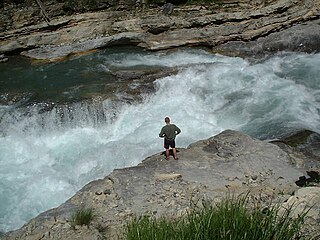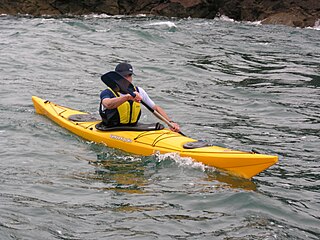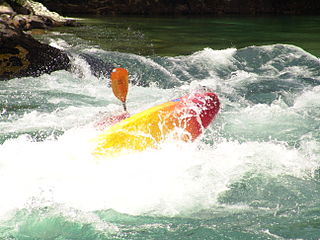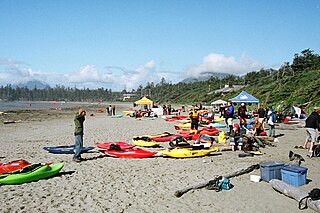Related Research Articles

A kayak is a small, narrow watercraft which is typically propelled by means of a double-bladed paddle. The word kayak originates from the Greenlandic word qajaq.

Kayaking is the use of a kayak for moving across water. It is distinguished from canoeing by the sitting position of the paddler and the number of blades on the paddle. A kayak is a low-to-the-water, canoe-like boat in which the paddler sits facing forward, legs in front, using a double-bladed paddle to pull front-to-back on one side and then the other in rotation. Most kayaks have closed decks, although sit-on-top and inflatable kayaks are growing in popularity as well.

A paddle is a tool used for pushing against liquids, either as a form of propulsion of a boat (paddling) or as an implement for mixing.

Whitewater is formed in a rapid, when a river's gradient changes enough to generate so much turbulence that air is trapped within the water. This forms an unstable current that froths, making the water appear opaque and white.
Canoe polo, also known as kayak polo, is one of the competitive disciplines of kayaking, known simply as "polo" by its aficionados.

A sea kayak or touring kayak is a kayak developed for the sport of paddling on open waters of lakes, bays, and the ocean. Sea kayaks are seaworthy small boats with a covered deck and the ability to incorporate a spray deck. They trade off the maneuverability of whitewater kayaks for higher cruising speed, cargo capacity, ease of straight-line paddling, and comfort for long journeys.

Whitewater kayaking is a recreational outdoor activity which uses a kayak to navigate a river or other body of whitewater or rough water.

A spraydeck is a flexible waterproof cover for a boat with holes for the passengers' waists. Spraydecks are used to prevent water from entering the boat while allowing passengers to paddle or row.

Canoe sprint is a sport in which athletes race canoes or kayaks on calm water.

Squirt boating is a form of whitewater kayaking or canoeing where the boat is designed to be as low in volume as possible while still allowing the paddler to float. Squirt boats are designed to use both surface and underwater currents to manoeuvre within the water. These manoeuvres can be used to effect navigational control or to perform tricks.

Surf kayaking is the sport, technique, and equipment, used in surfing ocean waves with kayaks. Surf kayaking has many similarities to surf board surfing, but with boats designed for use in surf zones, and with a paddle. A number of kayak designs are used, but all are aimed at better using the waves to propel the craft.

Canoe diving and Kayak diving are recreational diving where the divers paddle to a diving site in a canoe or kayak carrying all their gear in or on the boat to the place they want to dive. Canoe or kayak diving gives the diver independence from dive boat operators, while allowing dives at sites which are too far to comfortably swim, but are sufficiently sheltered.

Kayak fishing is fishing from a kayak. The kayak has long been a means of transportation and a means of accessing fishing grounds. Kayak fishing has gained popularity in recent times.

Creeking is a branch of canoeing and kayaking that involves descending very steep low-volume whitewater. It is usually performed in specialized canoes and kayaks specifically designed to withstand the extreme whitewater environment in which the activity occurs. In addition, the canoes and kayaks give the paddler improved performance and maneuverability needed to avoid river obstacles.

A kayak roll is the act of righting a capsized kayak by use of body motion and/or a paddle. Typically this is done by lifting the torso towards the surface, flicking the hips to right the kayak, and applying a small force by means of the paddle to assist the torso back over the boat.

An Eskimo rescue, bow rescue or T-rescue is a kayaking technique performed to recover a kayaker from a capsize without them having to leave their boat or perform a self-rescue such as a kayak roll. The advantages of this manoeuvre are that the kayaker does not have to get out of the kayak and the kayak does not then have to be emptied of water. However, it relies on another kayaker being able to assist quickly enough. More advanced kayakers will often prefer to rely on a kayak roll instead.

Sprint kayak is a sport held on calm water. The paddler is seated, facing forward, and uses a double-bladed paddle pulling the blade through the water on alternate sides to propel the boat forward. Kayak sprint has been in every summer olympics since it debuted at the 1936 Summer Olympics. Racing is governed by the International Canoe Federation.

The following outline is provided as an overview of canoeing and kayaking:

Nigel Foster is an English sea kayaker, kayak designer, instructor and author. He is the first and youngest paddler to circle Iceland by kayak.
Hans W Pawlata, known as "Edi", was an Austrian pioneer of the sport of kayaking; who in 1927, claimed to be the first European to perform a Kayak roll, a skill developed by the Eskimo people. In fact, a number of other Europeans had already learned to roll a kayak, but Pawlata is widely credited with the feat.
References
- ↑ "Paddling your sea kayak:The hip flick / hip snap". kayarchy.co.uk. Kayarchy. Retrieved 8 April 2014.
- ↑ Mark Dykeman; Kevin Redmond. "Unit 9: Sea Kayaking Lesson 3 Kayak Rolling". humankinetics.com. Human Kinetics. Retrieved 8 April 2014.
- ↑ "Recovery basics". kayakpaddling.net. KayakPaddling.net.
| This rowing-related article is a stub. You can help Wikipedia by expanding it. |